Fiber vs Cable Internet: Which Is Right For You?
Fiber vs Cable Internet: Which Is Right For You?
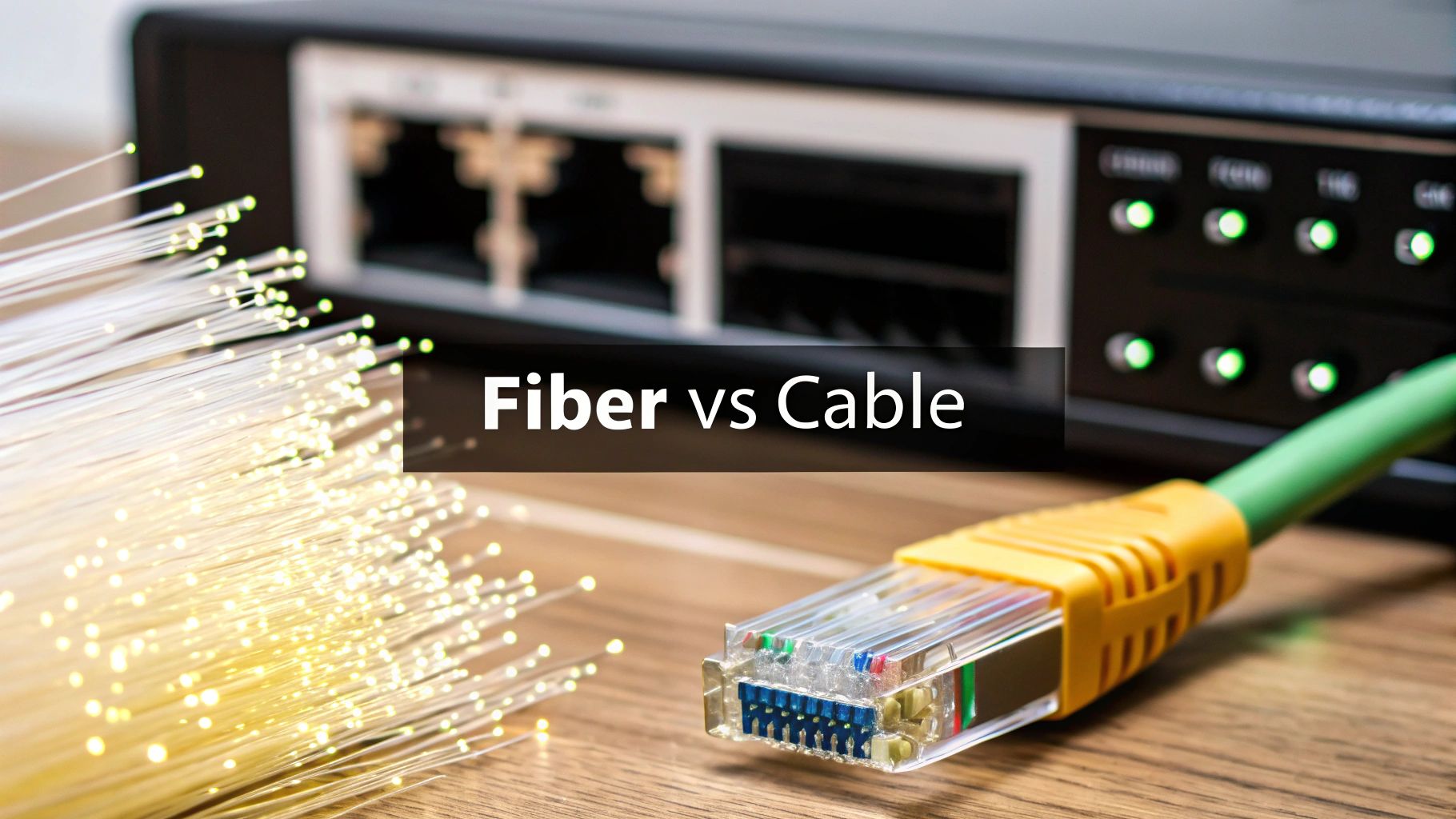
When you're picking your next broadband plan, the choice usually boils down to fibre versus cable internet. Let's be frank: fibre optic internet almost always wins on speed and reliability. It's built on modern tech that sends data as pulses of light, giving you a dedicated, super-fast connection that will transform your online experience.
Cable internet, on the other hand, runs on the same copper wiring as your TV service. It’s certainly widespread and can be cheaper, but you’re sharing that connection with your neighbours. That often means slower speeds when everyone jumps online in the evening. Don't settle for less when a superior connection is within reach.
Fibre vs Cable: A Quick Comparison
Trying to decide between fibre and cable can seem a bit technical, but what really matters is how they perform day-to-day in your home. This first look will help you get a handle on which one is the right fit before you start hunting for deals in your area.
The infographic below really nails the key differences in speed, cost, and reliability between the two.
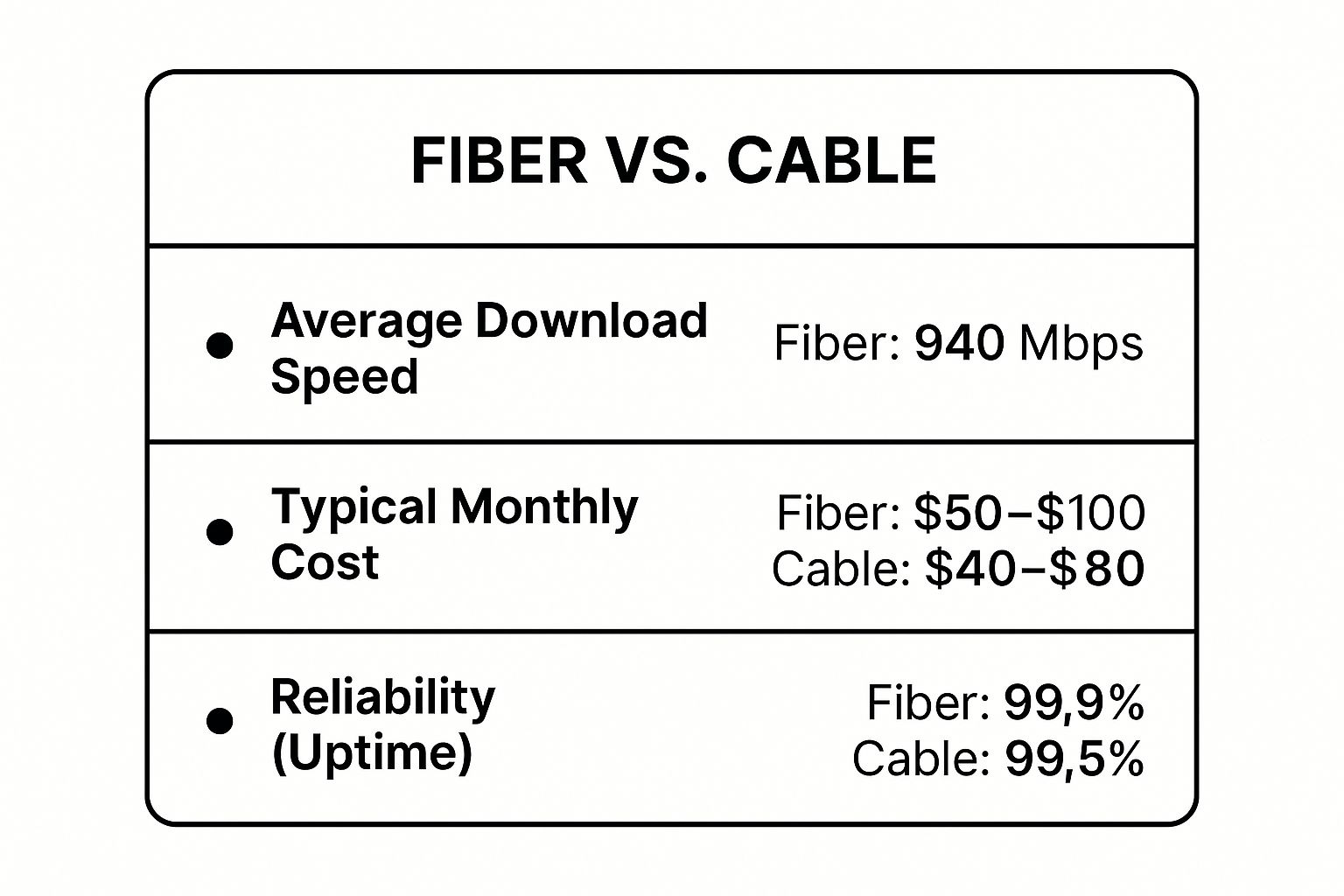
As you can see, fibre doesn't just inch ahead—it offers a massive leap in average speeds and uptime. It’s simply better technology, and you deserve the best.
The most crucial takeaway is this: while both can give you fast internet, only fibre offers a dedicated, interference-resistant connection. This means your speeds stay consistently high, even when the entire neighbourhood is online streaming, gaming, and working from home.
To make things even clearer, here’s a quick summary table comparing the core features of each service. Seeing it all side-by-side helps to show where you’re getting the best value for what you need.
Fibre vs Cable Internet At a Glance
Ultimately, fibre is the future-proof choice for anyone who relies on their internet for more than just casual browsing. For everyone else, cable can still be a solid, dependable option.
How The Technology Impacts Your Connection
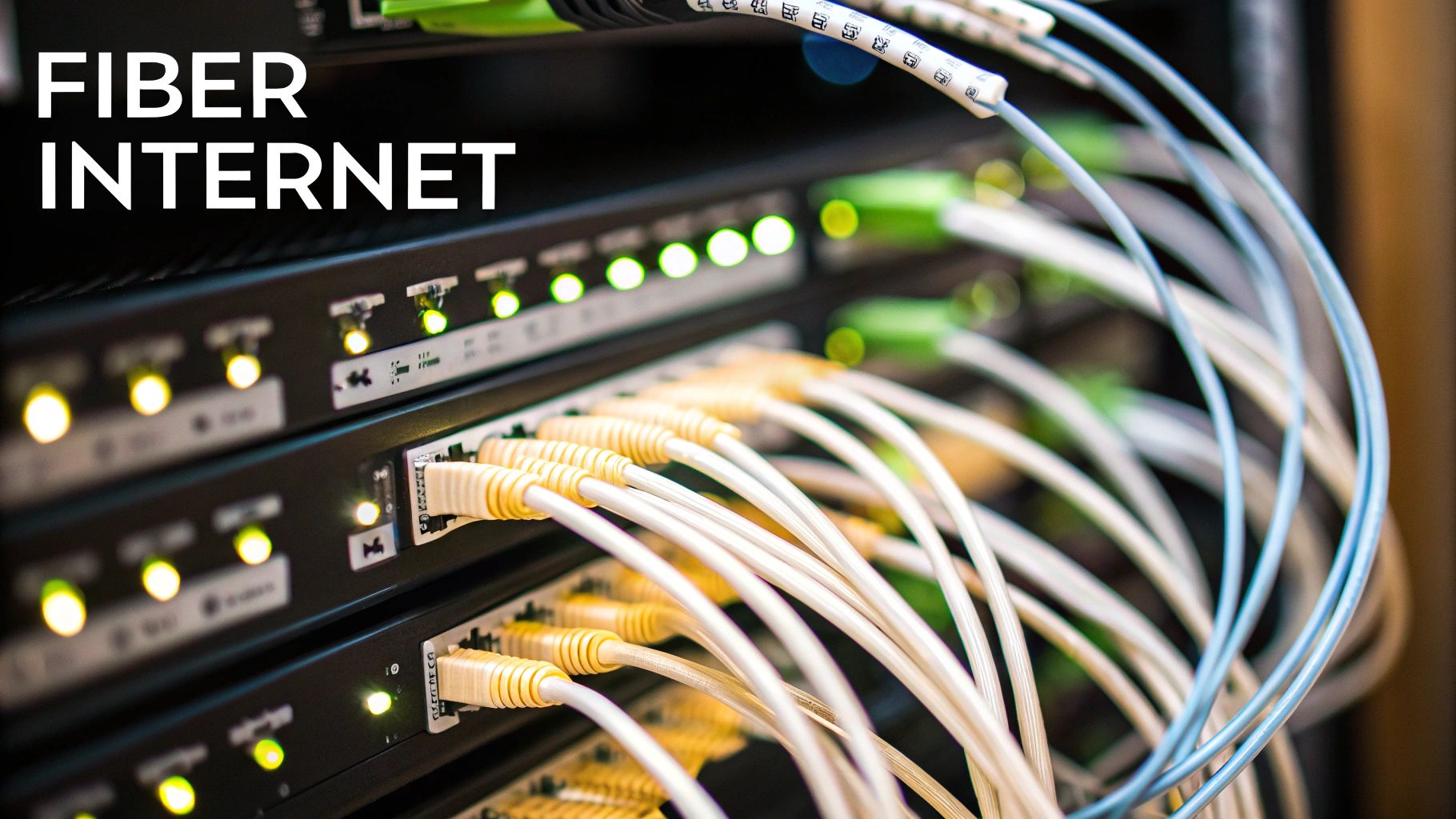
Before you can pick the right broadband, you need to get your head around the tech that makes it all work. The fibre vs cable internet debate isn't just about headline speeds; it's about how that data physically gets to your house. Honestly, understanding this is why moving to fibre is one of the smartest upgrades you can make for your home.
Fibre optic internet is pretty amazing stuff. It sends data as tiny flashes of light zipping through ultra-thin glass strands. The best way to think of it is having your own private, multi-lane motorway running directly from the provider to your router. The data travels at nearly the speed of light, giving you an unbelievably fast and stable connection.
Cable internet, on the other hand, runs on the same old copper coaxial lines that have been delivering TV signals for decades. It works by sending electrical signals down the wire. It gets the job done, but it has its limits. Think of it less like a private motorway and more like a busy A-road that you have to share with everyone else in your neighbourhood.
The Impact of Shared vs Dedicated Lines
So, what does this actually mean for your day-to-day use? The biggest difference is network congestion. Because all the cable connections in an area are lumped together and share the same main line, your speed is at the mercy of your neighbours. If everyone is streaming films, gaming online, or working from home at the same time, that shared "A-road" gets jammed up. The result? Everyone’s speed drops. You've probably noticed this during the "internet rush hour" in the evenings.
A fibre connection, being a dedicated line to your property, is like having a congestion-proof motorway. Your neighbours’ online activities have no impact on your speed or stability. Whether it’s 8 PM on a Friday or a quiet Tuesday morning, your connection remains consistently fast and reliable.
This rock-solid stability is exactly why we recommend switching to fibre whenever you can. You’re not just paying for faster speeds on paper; you're investing in a consistently brilliant experience. Use our affiliate link to check for providers to see what fibre deals are up for grabs in your area and lock in a connection that won’t bail on you when you need it most.
Future-Proofing Your Home Connection
Looking beyond today's performance, the technology you choose now determines how ready you are for the future. Cable's copper wiring is old tech that's been pushed and tweaked for modern internet, but it's getting very close to its physical limits.
Fibre optic lines, however, have an incredible amount of untapped potential. The speeds we get today are just a tiny fraction of what the technology is actually capable of. This means that as our demand for bandwidth inevitably grows with new gadgets and services, a fibre connection can easily keep up without needing a massive, disruptive upgrade.
Choosing fibre today is a strategic move that sets your home up for whatever the internet of tomorrow throws at it. Don’t wait for your cable connection to become a bottleneck; find a superior fibre plan with our partners and get a service that’s built to last.
Comparing Speed and Real-World Performance
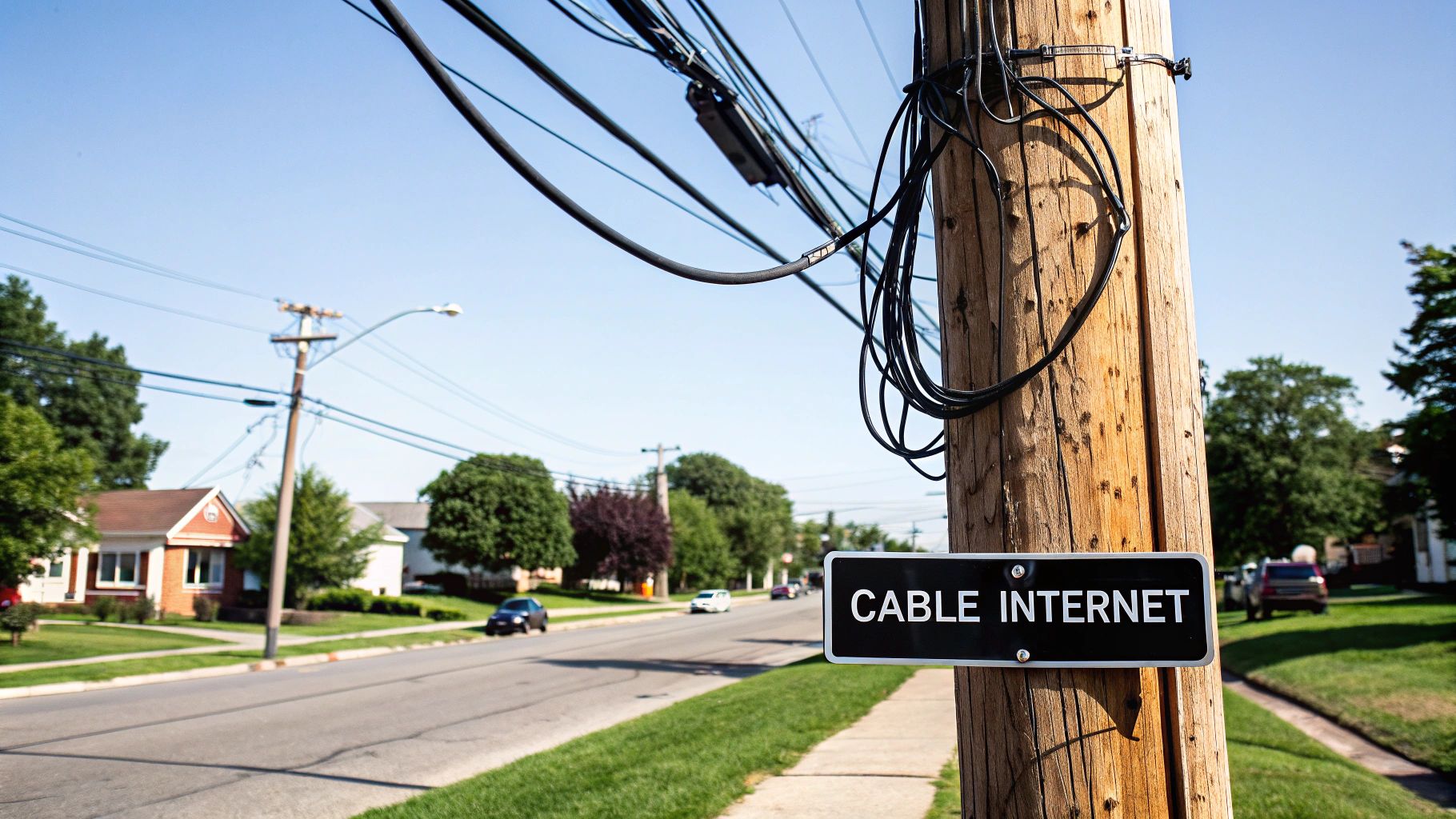
When you get down to it, comparing fibre and cable internet isn't just about the numbers you see on an advert. It’s about how smoothly your day-to-day digital life actually runs. This is where fibre broadband really shines, moving beyond a simple upgrade to become an essential tool for modern living. The secret? Symmetrical speeds.
Fibre gives you upload and download speeds that are identical. This is a game-changer. It means the digital pipeline sending information from your home is just as powerful as the one bringing it in. The real-world difference this makes is massive, turning a good online experience into a genuinely flawless one.
Symmetrical Speeds: The Fibre Advantage
Think about what you actually do online. Most of us aren't just passively watching films or browsing websites anymore; we're actively creating and sending things out. This is exactly where cable's asymmetrical speeds—fast for downloads, but painfully slow for uploads—can create some seriously frustrating bottlenecks.
Just look at these common situations where fibre’s symmetrical performance makes a huge, tangible difference:
- Working From Home: Ever been on a video call where someone's face is just a blocky, frozen mess? That's almost always down to a slow upload speed. On cable, your outgoing video stream struggles, but fibre keeps your feed crystal clear for your colleagues.
- Online Gaming: In competitive gaming, a split-second delay is the difference between winning and losing. Fibre's low latency and fast upload speeds ensure your commands hit the server instantly, giving you a crucial advantage. Cable’s sluggish uploads often lead to the kind of lag that ruins a match.
- Content Creation & Backups: If you're a YouTuber uploading large videos or just someone who backs up important files to the cloud, cable's upload limits can turn these tasks into an overnight chore. With fibre, a file that might take hours to upload on cable can be done and dusted in just a few minutes.
The bottom line is that modern internet use is a two-way street. By putting all the emphasis on downloads, cable internet was designed for an older, more passive way of using the web. Fibre is built for how we live now—interactive, collaborative, and constantly connected.
Choosing a fibre plan isn't just about getting faster downloads for streaming the latest series. It's an investment in a frustration-free experience for everything you do online.
The Future is Fibre, and It's Closer Than You Think
The fantastic news for UK residents is that this superior technology is becoming more and more common every single day. In fact, the UK is on track to hit 96% fibre broadband coverage by 2027—a massive leap from just 24% back in 2021. This rapid expansion, driven by Ofcom and providers like Openreach, means millions more homes now have access to a truly better connection.
This incredible growth makes now the perfect time to make the switch. Figuring out exactly what speed you need can seem complicated, but it's vital for getting the best value for your money. To help you out, have a look at our guide on how much broadband speed you actually need. It’ll help you match a plan to what your household really uses, making sure you only pay for what you'll use.
Which Connection Offers Better Reliability
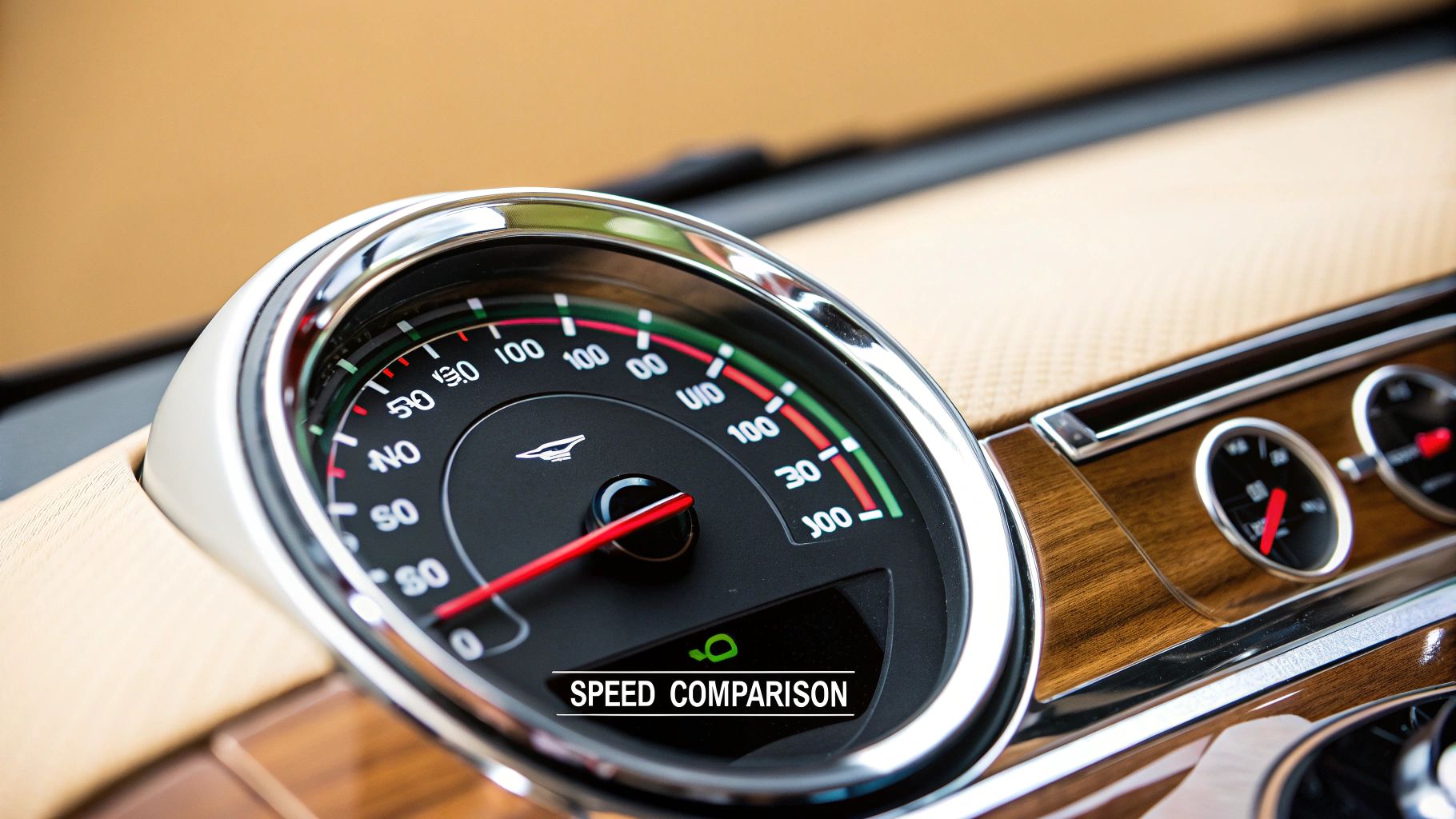
A lightning-fast internet connection is pretty useless if it keeps dropping out. When it comes to fiber vs cable internet, reliability is a huge deal, and this is another area where fibre optics has a clear edge. It all comes down to the underlying technology and how the network is structured.
Because fibre optic cables are made from glass and use light to send data, they're completely immune to electromagnetic and radio frequency interference. This means all the little gremlins that can mess with older copper cable networks—like interference from power lines or even bad weather—simply don't faze a fibre connection.
The Problem With Shared Networks
The biggest reliability issue for cable internet is its shared infrastructure. Your connection is part of a local loop, meaning you share bandwidth with dozens of other homes in your neighbourhood. This design is what creates that dreaded "internet rush hour."
You know the feeling. It's evening, everyone jumps online to stream, game, or browse, and suddenly the network gets congested. Your speeds tank and the connection becomes less stable, right when you need it most. It's an unavoidable limitation of the technology itself.
Fibre-to-the-premises (FTTP) gives you a dedicated, direct line from the exchange straight to your home. Your connection's performance is completely independent of what your neighbours are doing online, guaranteeing consistent speed and rock-solid uptime, day or night.
Choosing a fibre plan isn't just about chasing the fastest speeds; it's about getting a stable and predictable connection you can actually depend on. This is especially important for anyone working from home or for families with multiple devices all competing for bandwidth at the same time.
Securing a Dependable Connection
Ultimately, fibre’s superior build and dedicated network make it the obvious winner for anyone who values a reliable internet service. It's just built to be less susceptible to the outside interference and network congestion that can trip up a cable connection.
Making the switch to a more dependable service is often easier than you'd think. By checking out some of the fastest internet providers in the UK, you can find some fantastic fibre deals available in your area. Opting for a quality fibre provider means you're investing in an uninterrupted connection that will reliably support your work, entertainment, and digital life for years to come.
Cost vs Value Across The UK
When you're weighing up fibre vs cable internet, the monthly price is usually the first thing that catches your eye. For years, cable has been seen as the cheaper, more budget-friendly choice, but that’s an outdated view, especially now in the UK. The real question isn't "what's cheapest?" anymore. It's "what gives me the best value for my money?"
Thinking only about the monthly bill is a classic mistake. Real value is a connection that just works—one that handles everything you throw at it without a single hiccup. A cheap cable plan that buffers during Netflix primetime or drops out during a crucial video call isn't a bargain. It's a daily frustration you're paying for, and this is where fibre's long-term worth really shines through.
Beyond The Monthly Fee A Smarter Investment
When you opt for a fibre plan, you're not just buying internet. You're locking in superior, consistent performance that pays for itself in sheer reliability and a stress-free online life. The price difference between a mid-range cable plan and an entry-level fibre package is often surprisingly small these days, but the performance gap is huge.
Think about what you're really getting with fibre:
- Future-Proof Performance: Fibre optics have a much higher performance ceiling. It's built to handle the next generation of smart devices, 8K streaming, and whatever else is coming without needing a massive infrastructure change.
- Enhanced Productivity: If you work from home, you know that seamless video calls and speedy file uploads aren't just nice-to-haves; they're essential. Fibre’s symmetrical speeds mean no more upload bottlenecks, making your workday far more efficient.
- Superior Entertainment: A solid fibre connection guarantees buttery-smooth 4K streaming and zero-lag gaming, even when everyone else in the house is online. That’s a level of reliability cable’s shared network just can’t promise during peak evening hours.
The old story that fibre is some expensive luxury just doesn't hold up anymore. With competitive pricing and its network spreading like wildfire, it’s a smart, long-term investment in your home's digital backbone.
The rollout of full-fibre across the nation has been incredibly fast, meaning better deals are popping up all the time. As of December 2024, a staggering 69% of UK homes can now get a full-fibre connection. That's a massive leap from just 57% in late 2023. You can read more about this impressive growth and see how Northern Ireland is smashing it with 93% coverage in the latest Ofcom report on UK broadband speeds.
This explosion in availability has ignited fierce competition between providers, resulting in fantastic introductory offers and price cuts. Never assume a top-tier connection is out of your price range. Making the right choice is key, and our detailed guide on how to choose the best internet provider walks you through everything you need to consider.
The only way to know the true value is to see what’s on offer at your specific postcode. Use our affiliate links to check providers in your area—you might just find that a faster, more reliable fibre plan is easily within your budget. It’s time to invest in a connection that actually delivers.
Which Internet Plan Is Best for You?
So, let's cut through the technical jargon of the fibre vs cable internet debate and get straight to what matters: which one is right for you? There’s no single best answer; it all comes down to how you actually use the internet day-to-day.
To figure this out, we'll look at a couple of common households. Are you part of a busy family trying to juggle 4K streams, online classes, and gaming all at once? Or maybe you're a professional working from home, where your entire career relies on a perfect connection. By seeing which profile fits your life, it becomes clear why fibre’s performance is almost always the winner.
The Power User Family
For a family where everyone is online at the same time, a typical cable connection will start to buckle under the pressure pretty quickly. Just picture it: someone’s watching a film in 4K, another person is on an important work video call, and a third is downloading a massive game update. On a shared cable network, that’s a perfect storm for buffering, stuttering video, and frustrating lag for everyone involved.
Fibre internet just makes this whole problem disappear. Because you have your own dedicated connection and symmetrical speeds, the "Power User Family" can do all of this simultaneously without a single hiccup. Everyone gets the speed and stability they need, no compromises.
For the modern, connected family, fibre isn't just a nice-to-have—it's an essential utility. It puts an end to the arguments over who's "hogging the internet" and guarantees a smooth online experience for the whole house.
If that sounds like your home, it’s probably time to stop putting up with an outdated connection. Discover the perfect fibre plan for your family with our trusted partners and give everyone the bandwidth they deserve.
The Home Office Hero and Competitive Gamer
If you work from home or take your gaming seriously, your upload speed is every bit as crucial as your download speed. Cable’s sluggish uploads can make you look unprofessional with a glitchy video feed or put you at a serious disadvantage in a game thanks to high latency (or lag).
Fibre’s symmetrical speeds are the obvious fix. Your video calls will be flawlessly clear, big file transfers will take minutes instead of hours, and your gaming will feel incredibly responsive.
The best part is that getting your hands on this superior tech is easier than you might think. Between late 2024 and mid-2025, full-fibre coverage in the UK rocketed to 73% of premises. That means 22.5 million homes and businesses can now get a connection. This huge expansion means better options and prices are now available to millions. You can read more about this impressive UK rollout in the latest coverage reports from Capacity Media.
Don’t let a dodgy connection hold back your career or your hobbies. Check for high-speed fibre deals in your area using our affiliate links and lock in a connection that performs when it matters most.
Frequently Asked Questions
Still weighing up fibre and cable? I get it. Making the right call can feel like a big decision. Let’s tackle some of the most common questions I hear to give you that last bit of clarity you need.
Is Fibre Internet Always More Expensive?
Not anymore. This is probably the biggest myth that puts people off switching.
As fibre networks have expanded like crazy, the prices have become seriously competitive. It’s now common to find entry-level fibre plans that cost the same as—or sometimes even less than—mid-tier cable packages. The kicker? You're getting a far faster and more stable connection for your money.
Will I Need New Equipment for Fibre?
Yes, but don't worry, it's all handled for you during the installation.
A fibre setup requires a small box called an Optical Network Terminal (ONT). Think of it as the modern replacement for a cable modem. Your provider will supply and install this for you, making the whole process completely straightforward.
The most important thing to remember is that you're not just paying for speed; you're investing in reliability and future-proof technology. The value you get from a stable, high-performance fibre connection is unmatched.
Ultimately, the only way to know the real cost is to see what’s available at your specific address.
Ready to see what amazing fibre deals you can get? Humble Reviewer makes it easy to compare the best providers in your area. Check for superior fibre plans now!
